 |
|

| |
|
The Slovakian
Slovakians from Upper Hungary often visited the Great Plain from the second half of the 17th century to do harvest work so they new this rich and uncultivated land. Migration was instinctive and consciously organized at the same time. Their new home provided rights for the localized serves and free practice of their religion for the Lutherans. Ambitions naturally joined to the economical, social and philosophical factors. Towns and developing settlements, like Békéscsaba, Mezőberény, Szarvas and Tótkomlós formed the type of the Slovakian settlements that developed in the first half of the 18th century. The centre of these wide-bordered settlements were surrounded by farms and created the typical kind of settlement from the end of the 18th century: in Tótkomlós a circle-shaped settlement with a pen and garden, in Szarvas the system of row of farms. The buildings of Slovakians, who lived at the southern part of the Great Plain, were built with the technology of mud wall (paticsfal) in the 18th century. So in Szarvas thatched houses with special gable, called "félkanfaros", in Békéscsaba the typical house with visor protruding to the street and the developed version with a patio (podst’enka), which was separated by a door from the brick patio, were popular. It is a speciality of Tótkomlós that granaries are standing next to the house parallel to the front of the street giving the impression of a castle. The old Slovakian peasant cottage without a patio in Mezőberény preserved the once authoritative house type (divided into three) of the Plains.
In the independently built and enriching farms the number of civil-peasants continuously increased by the beginning of the 19th century. In Szarvas the biggest peasant landed properties reached the size of 300 Hungarian acres, 200 in Békéscsaba. The wealthy farmers in Tótkomlós owned the average of 120 Hungarian acres, they insisted on the Slovakian common customs the most consistently. At the turning of the 19th and 20th century the civil institutions, transmitting the mother tonge, developed among the Lutheran Slovakian communities. The Czech bible and the Tranoscius, the Funebral, containing funeral songs in Slovakian, became the ethnic symbol of the Lutheran Slovakian.
Furniture
In Békés County the oldest type of Slovakian folk furniture was represented by trousseau chests that were scaffolded of oak from Gömör and Nógrád and had notched technology with carved archaic, geometric and figure ornaments. Until the middle of the 19th century farmers, who were talented and insisted on the traditions of Upper Hungary, made their own notched chests (szkrinya) themselves. By the end of the 18th century two complete furniture-maker centres of our county were established in Tótkomlós and Békéscsaba. As a result of German craftsmen, who were well-up in Europe and made church furniture and the carpenters’ in Hódmezővásárhely, a new local style was created. Their pieces were equal to the type that was well-known all over the Great Plain, but the same time with chased, clipping and convex carving, rich colouring, and typical Gothic-style writings they realized a mature artistical execution. The early throne-like thiking chairs of Békéscsaba and Komlós, backed chairs, seats and mirror frames indicate Renaissance forms. The screwed columned, canopied beds and cupboards reflect Baroque ornaments. This time the dominating colours of the furniture of Komlós are dark blue, the flowers are green, red, white, yellow and occasionally brown. From the second half of the 19th century light blue and green appear more often as the colour of the base and carving was pushed to the background by painted flowers.
The furniture of Csaba was more simple and solid. The base colour of the early convex carved furniture is blue, later green, and rarely brown. The flowers were white, yellow, blue and green, sometimes red. From the middle of the 19th century the furniture dominates that has dark green base and blue, red yellow and white motifs. Then, by the end of the 19th century the base was changed to yellowish white instead of dark green. In the clean room veined (flóderes) cupboards were popular.
|
| | 
|
| |
bedcrown
"Origin: Tótkomlós, Techniqe: By Sebeők Sámuel, a joiner in Tótkomlós, with sawn ornaments, two-headed, stylized eagle, on dark green basis a hand-painted colourful bunch of flowers with a pitcher,""Anno 1846"" Size: H: 82 cm L: 70 cm" |
|
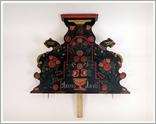

| | 
|
| |
box for ribbons
"Origin: Békéscsaba Technique: oval chest with a lid made of soft-wood, ornaments of hand-painted flowers, fixed on it: ""IHS"" Size: L: 37 cm H: 20 cm" |
|
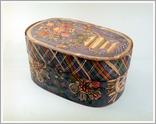

| | 
|
| |
box for ribbons
Origin: Békéscsaba Technique: Thin pine lamina, arched, oval, box with a lid, hand painted flowers. Size: H: 8 cm Bottom: 14 cm |
|
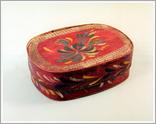

| | 
|
| |
box for ribbons
Origin: Békéscsaba Technique: Thin pine lamina, arched, oval, box with a lid, red, blue, green hand painted flowers. Size: H: 15 cm W: 26 cm |
|
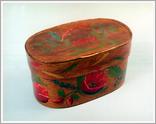

| | 
|
| |
box for ribbons
Origin: Békéscsaba Technique: Thin pine lamina, arched, oval, box with a lid, hand painted flowers. |
|
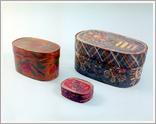

| | 
|
| |
canopied bed
Origin: Békéscsaba Technique: The top of the bed is decorated with colourful, wooden, lathe-turned bells. |
|
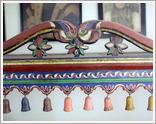

| | 
|
| |
canopied bed
"Origin: Békéscsaba Technique: made of pine-wood, crown is profiled, flowers on blue basis,red, white and green stringed painting on the twisted poles, writing on the blue canopy divided into two halves: ""1857"" Size: H: 183 cm W: 135 cm" |
|
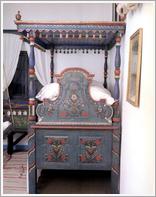

| | 
|
| |
chair
"Origin: Tótkomlós Technique: Made of oak, Baroque styled back with pierced carving, shape of a heart in the middle, writing: ""Anno 1822"" Size: H: 101 cm W: 44 cm" |
|
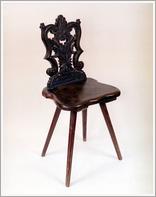

| | 
|
| |
chair
"Origin: Tótkomlós Technique: Carved from oak, Baroqe styled back, arched cuttin on the edge, pierced carving: red, white, brown, green flowers on branches, writing on blue basis: ""Szokolay Pál roku páne 1899""" |
|


| | 
|
| |
chair
Origin: Tótkomlós Technique: Carved from oak, Baroque style, arched edges, motifs of hearts on the pierced back, brown and green painted flowers on blue basis. Size: H: 92 cm seat: 37.5 cm x 45 cm |
|


| | 
|
| |
chair
"Origin: Békéscsaba Technique: its sitting surface is made of beech, the back is made of pine-wood, arched, pierced carving: leaves on branches, heart in the moddle, convex carving inside: ""1803"", two birds above, green basis. Size: H: 89 cm Seat: 33 cm x 43 cm" |
|
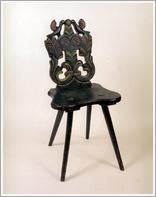

| | 
|
| |
chair
Origin: Békéscsaba Technique: Carved from hard-wood, convex, pierced carving on the back, convex at the bottom, painted coat of arms with an eagle Size: L: 40 cm H: 102 cm W: 47 cm |
|
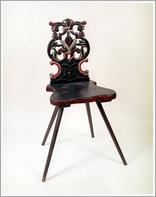

| | 
|
| |
chair
"Origin: Tótkomlós Technique: carved from pine-wood, heart shaped, pierced carving in the middle, profiled back, red, yellow, blue flowers on dark basis, writing with Gothic letters: ""Powázai Sámuel"", ""1902"" Size: H: 99 cm Seat: 39 cm x 41 cm" |
|
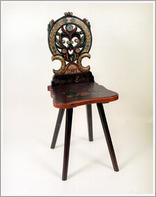

| | 
|
| |
chest
"Origin: Tótkomlós Technique: made of pine-wood, drawer of chest inside, lid and the front painted with dark brown oil, red and white bunches of flowers at the four corners of the lid, garland in the centre, writing: ""Pálinkás Ilka 1857"" Size: L: 96 cm W: 54.5 H: 65 cm" |
|
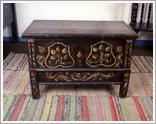

| | 
|
| |
chest
"Origin: Mezőberény Tecjnique: Work of a joiner from Berény, made of pine-wood, drawer o chest inside, painted, flowered, writing on top: ""Bobály Anna 1861"" Size: L: 99 cm W: 58 cm H: 75 cm" |
|
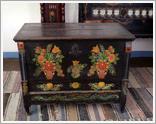

| | 
|
| |
child's chair
"Origin: Tótkomlós Technique: made of hard.wood, seat is wicker-work, writing on the pierced back: ""Lehoczki Mátyás R P 1902"" Size: H: 70 cm W: 37 cm L: 37 cm" |
|
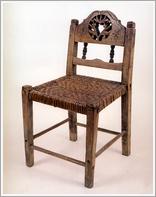

| | 
|
| |
clock-boot
"Origin: Tótkomlós Technique: Carved from pine-wood, standing on four lathe-turned legs, two lathe-turned poles on the two sides, painted writing in Gothic letters on dark brown basis: ""…jános R. P. 1888"". Size: H: 159 cm W: 27 cm L: 36 cm" |
|


| | 
|
| |
corner-file
Origin: Tótkomlós Technique: Made of pine-wood, Baroque styled, five-cornered door narrow in the front, under that two drawers, dark blue prime colour, painted on three sides: red, yelow, white oval garland Size: H: 125 cm L: 32 cm W: 37 cm |
|
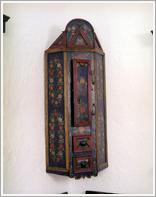

| | 
|
| |
cradle
Origin: Tótkomlós Technique: made of pine-wood, shape of a flat box, clipped carving on the two long sides, 3-3 hanging hooks on the lower edge, heads of birds and tulip endings on the top, yellow, red, white flowers on dark green basis. Size: L: 99 cm x 48 cm D: 23 cm |
|


| | 
|
| |
cradle, toy
"Origin: Tótkomlós Technique: Made of soft-wood, swinging sole, blue, white, red flowes on brown basis, writing: ""Farkas Marka Anno 1889"".
Size: L: 33 cm x 22 cm H: 23 cm" |
|


| | 
|
 |
1-20 / 39 |  |
|
|
|
